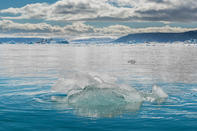Glaciers Melting
The central and eastern Himalayan glaciers may disappear by 2035. Arctic sea ice has thinned by 40 percent during the late summer and early autumn months and the loss of sea ice is posing a dire threat to the survival of polar bears, seals and Inuit communities. The Arctic is warming faster than anywhere else because of the albedo effect - more ice melts, therefore greater amounts of dark ground are exposed to absorb rather than reflect the Sun's energy, and the regional temperature climbs.

In Fairbanks, Alaska, permafrost is melting. Roads built level on solid, frozen ground now look like crumpled carpets, becoming higgledy-piggledy as the ground beneath them turns soggy. Trees that were once supported upright by the frozen ground have started lolling drunkenly.
Further south, on the underbelly of the planet, the Larson B ice shelf - a massive slab of ice floating off the eastern edge of the Antarctic Peninsula - disintegrated in 2002 as 12 500 square kilometres of ice broke off into icebergs and floated away into the Weddell Sea. This happened in as little as 35 days after 10 000 years of stability. Steady warming by 2.5°C has been recorded here over the past 50 years.
Heat Waves

In August 2003 Britain's Department of Health issued guidelines on how to cope with an impending heat wave. When it struck, the mercury hovered in the mid-30s before climbing beyond anything ever recorded in Britain. Poultry farmers later began switching to maize and sunflower crops because of the mortality rate of their birds in the heat. Rail services ground to a halt when temperatures threatened to buckle the tracks.
Wine farmers from the Champagne region of France began scouting for property along the chalky slopes of south-east England as steady warming made the area look more and more agreeable for producing the crisp, acidic wines needed for a good bubbly. Across the channel, the rest of Europe was struggling with the same record-breaking heat wave which pushed up temperatures by 3.5°C higher than average, causing what was probably the hottest summer that region had experienced in 500 years.
Heatwave episodes will continue into the future and will probably be worse in cities, where urban heat islands, in which heat is trapped over cities due to a complicated interaction of evaporation processes, impervious surfaces and changed vegetative cover, could push up the temperature by 5 to 11°C compared to that experienced outside of the city.
Dr Myles Allen, at Oxford University's physics department, wrote in the journal ‘Nature’ that the heat wave which swept through Europe was the result of an anticyclone where greenhouse gas emissions had 'loaded the weather dice, increasing the risk of an anticyclone causing a heat wave like that of 2003 by around a factor of four'.
Spreading of Disease

The World Health Organization and the United Nations Intergovernmental Panel on Climate Change predict that climbing temperatures and changing rainfall regimes will increase the spread of infectious diseases such as malaria and dengue fever.
The incidence of diarrhoeal disease and salmonella-related food poisoning can also be expected to climb, while changing weather patterns will undermine food security, leading to malnutrition and increased vulnerability. The World Health Organization estimates that, since the 1970s, over 150 000 deaths every year can be directly linked to climate change.
Tidal Waves
The occasional normal upwelling of tides - where sea water rises up through the sponge of coral rock upon which the people here live - gathers in puddles on the ground before becoming rivulets as water inundates gardens, airstrips and roads.
This upwelling is happening more and more frequently. Because most of the nation is less than 50 cm above sea level, there isn't much margin for error for the people of Tuvalu - they are facing a national crisis. The Maldives and the islands and atolls of Kiribati face similar inundation.
Hurricanes
In March 2004 a hurricane ripped through the Santa Catarina province in Brazil. At 145 km per hour, it was an entry-level hurricane - nothing like the category five (a meteorological euphemism for 'devastating') Hurricane Ivan, which tore through the Gulf of Mexico later that year at 270 km per hour.
What made the relatively mild-mannered Hurricane Catarina special, though, is that it wasn't supposed to exist at all. It emerged out of the cooler South Atlantic Ocean. Hurricanes form in the 'doldrums' of the ocean between latitudes 10 degrees north and 10 degrees south where prevailing low-pressure troughs notoriously used to leave sailing ships of yore limp-sailed and stranded at sea.
Hurricanes need a sea surface temperature of 27°C or more in order to form. Hot, moisture-laden air is forced upwards, followed by colder air rushing in from the periphery, creating a storm with high winds circling inwards towards a central 'eye'. In the Atlantic, these conditions usually only occur north of the equator. The Hadley Centre for Climate Prediction and Research, part of the United Kingdom's Meteorological Office, said Catarina was the first ever recorded hurricane in the traditionally cooler South Atlantic.
It has long been understood that a rising sea surface temperature will drive bigger and more ferocious hurricanes. Evidence suggests such storms have been growing longer lifespans and greater intensity for three decades already - linked directly to warming seas in the area - and the trend is expected to continue into the future.
And if the horror that Hurricane Katrina wrought on the Mississippi Delta in 2005 is anything to go by, a community caught weak or ill-prepared can be crippled by a natural disaster of this magnitude. The ongoing changes in climate are global and they appear to be gaining momentum.
By Leonie Joubert